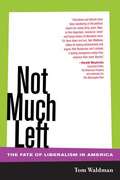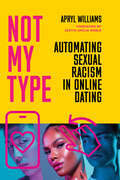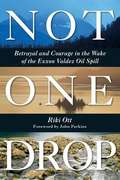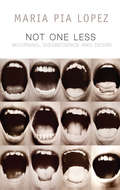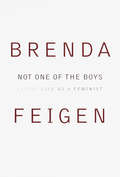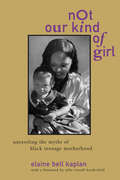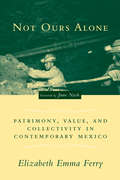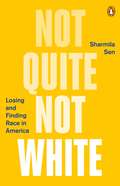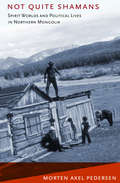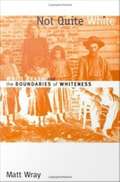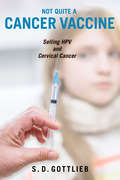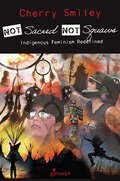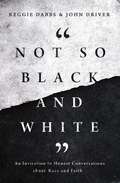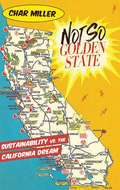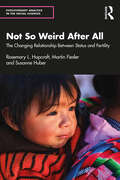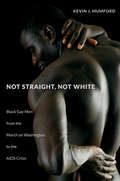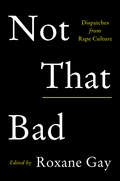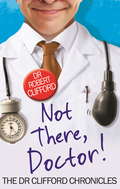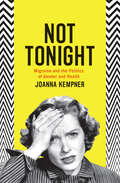- Table View
- List View
Not Much Just Chillin': The Hidden Lives of Middle Schoolers
by Linda PerlsteinA report from the front lines of the most formative-and least understood-years of children's livesSuddenly they go from striving for A's to barely passing, or obsessing for hours over "boyfriends" they've barely spoken to. Former chatterboxes answer in monosyllables; free-thinkers mimic their peers' clothes, not to mention their opinions. Bodies and psyches morph under the most radical changes since infancy. On the surface, they're "just chillin'." Underneath, they're a stew of anxiety and ardor, conformity and rebellion. They are kids in the middle school years, the age every adult remembers well enough to dread. No one understands them, not parents, not teachers, least of all themselves-no one, that is, until Linda Perlstein spent a year immersed in the lives of suburban Maryland middle-schoolers and emerged with this pathbreaking account. The book traverses the school year, following five representative kids-and including the stories of many more-as they study, party, IM each other, and simply explain what they think and feel. As Perlstein writes about what she saw and heard, she explains what's really going on under the don't-touch-me facade of these critically formative years, in which kids grapple with schoolwork, puberty, romance, identity, and new kinds of relationships with their parents and peers. Not Much Just Chillin' offers a trail map to the baffling no-man's-land between child and teen, the time when children don't want to grow up, and so badly do.
Not Much Left: The Fate of Liberalism in America
by Tom WaldmanTom Waldman's lively and sweeping assessment of the state of American liberalism begins with the political turbulence of 1968 and culminates with the 2006 takeover of Congress by the Democratic Party.
Not My Type: Automating Sexual Racism in Online Dating
by Apryl WilliamsIn the world of online dating, race-based discrimination is not only tolerated, but encouraged as part of a pervasive belief that it is simply a neutral, personal choice about one's romantic partner. Indeed, it is so much a part of our inherited wisdom about dating and romance that it actually directs the algorithmic infrastructures of most major online dating platforms, such that they openly reproduce racist and sexist hierarchies. In Not My Type: Automating Sexual Racism in Online Dating, Apryl Williams presents a socio-technical exploration of dating platforms' algorithms, their lack of transparency, the legal and ethical discourse in these companies' community guidelines, and accounts from individual users in order to argue that sexual racism is a central feature of today's online dating culture. She discusses this reality in the context of facial recognition and sorting software as well as user experiences, drawing parallels to the long history of eugenics and banned interracial partnerships. Ultimately, Williams calls for, both a reconceptualization of the technology and policies that govern dating agencies, and also a reexamination of sociocultural beliefs about attraction, beauty, and desirability.
Not One Drop
by Riki OttThis DVD/book package should be read and viewed by everyone concerned with crimes against man and nature; about corporate lies and the value of community. Betrayed by oilmen's promises in the 1970s, the people of Prince William Sound, Alaska, awaken on March 14, 1989, to the nation's largest oil spill. Not One Dropis an extraordinary tale of ordinary lives ripped apart by disaster and of community healing through building relationships of trust. This story offers critical lessons for a society traumatized by political divides and facing the looming catastrophe of global climate change. Author Riki Ott, a rare combination of commercial salmon "fisherm'am" and PhD marine biologist, describes firsthand the impacts of oil companies' broken promises when the Exxon Valdez spills most of its cargo and despoils thousands of miles of shore. Ott illustrates in stirring fashion the oil industry's 20-year trail of pollution and deception that predated the tragic 1989 spill and delves deep into the disruption to the fishing community of Cordova over the following 19 years. In vivid detail, she describes the human trauma coupled inextricably with that of the sound's wildlife and its long road to recovery. Black Wave (DVD) -directed by Robert Cornellier, tells the story of the biggest environmental catastrophe in North American history. In a flash, dramatic images shoot across the planet. They show thousands of carcasses of seabirds and sea otters covered in oil. A thick black tide rises and covers the beaches of once-pristine Prince William Sound. For twenty years Riki Ott and the fishermen of the little town of Cordova, Alaska have waged the longest legal battle in U. S. history against the world's most powerful oil company - ExxonMobil. They tell us all about the environmental, social and economic consequences of the black wave that changed their lives forever. Not One DropandBlack Waveshow us how too many corporate owners and political leaders betray everyday citizens and how a community forges a new path from despair to hope.
Not One Less: Mourning, Disobedience and Desire (Critical South)
by Maria Pia LopezOn June 3, 2015, massive women’s street demonstrations took place in many cities across Argentina to protest against femicide. Under the slogan Ni una menos, Not One (Woman) Less, thousands of women took to the streets to express their outrage at systematic violence against women, giving a face and a voice to women who might otherwise have died in silence. Maria Pia López, a founding member and active participant in the Not One Less protest, offers in this book a first-hand account of the distinctive aesthetics, characteristics and lineages of this popular feminist movement, while examining the broader issues of gender politics and violence, inequality and social justice, mourning, performance and protest that are relevant to all contemporary societies. A unique analysis of a social movement as well as a rich and original work of feminist theory and practice, this book will appeal to a wide readership concerned about gender based violence in the neoliberal contexts and what can be done to resist it.
Not One of the Boys: Living Life as a Feminist
by Brenda FeigenFrom an outspoken feminist, a leader of the Women's Movement in the 1960s and '70s--a candid, wide-ranging and deeply personal memoir that is, as well, an illuminating historical document of a time and a fight for profound societal change.Brenda Feigen has lived many lifetimes within one--lawyer, wife and mother, civil rights activist, politician, Hollywood movie producer--and in each she has faced down the specter of discrimination against women. She describes how at Harvard Law School she fought to change blatantly sexist practices such as Ladies' Days and law-firm interviewing processes; how she waged battles for women as National Vice President of NOW; how, with Gloria Steinem, she founded Ms. and cofounded the National Women's Political Caucus in the early 1970s; how she became director with Ruth Bader Ginsburg of the ACLU's Women's Rights Project in 1972; and how, in Hollywood, she met obstacles at every turn while fighting for movies with strong, positive roles for women. She describes, as well, the struggles and triumphs of her private life: her marriage (she and her husband were once considered "the perfect feminist couple"); being a (feminist) mother; her relationships with women; her breast cancer. Finally, she chronicles recent advances and losses in the Women's Movement, making clear how far women have come, and how far they have yet to go.
Not Our Kind of Girl: Unravelling the Myths of Black Teenage Motherhood
by Elaine Bell KaplanOne of the most worrisome images in America today is that of the teenage mother. For the African-American community, that image is especially troubling: All the problems of the welfare system seem to spotlight the black teenage mom. Elaine Bell Kaplan's affecting and insightful book dispels common perceptions of these young women. Her interviews with the women themselves, and with their mothers and grandmothers, provide a vivid picture of lives caught in the intersection of race, class, and gender.Kaplan challenges the assumption conveyed in the popular media that the African-American community condones teen pregnancy, single parenting, and reliance on welfare. Especially telling are the feelings of frustration, anger, and disappointment expressed by the mothers and grandmothers Kaplan interviewed. And in listening to teenage mothers discuss their problems, Kaplan hears first-hand of their misunderstandings regarding sex, their fraught relationships with men, and their difficulties with the educational system—all factors that bear heavily on their status as young parents.Kaplan's own experience as an African-American teenage mother adds a personal dimension to this book, and she offers substantial proposals for rethinking and reassessing the class factors, gender relations, and racism that influence black teenagers to become mothers.
Not Ours Alone: Patrimony, Value, and Collectivity in Contemporary Mexico
by Elizabeth Emma FerryElizabeth Ferry explores how members of the Santa Fe Cooperative, a silver mine in Mexico, give meaning to their labor in an era of rampant globalization. She analyzes the cooperative's practices and the importance of patrimonio (patrimony) in their understanding of work, tradition, and community. More specifically, she argues that patrimonio, a belief that certain resources are inalienable possessions of a local collective passed down to subsequent generations, has shaped and sustained the cooperative's sense of identity.
Not Quite Not White: Losing and Finding Race in America
by Sharmila SenAt the age of 12, Sharmila Sen emigrated from India to the U.S. The year was 1982, and everywhere she turned, she was asked to self-report her race - on INS forms, at the doctor's office, in middle school. Never identifying with a race in the India of her childhood, she rejects her new "not quite" designation - not quite white, not quite black, not quite Asian -- and spends much of her life attempting to blend into American whiteness. <p><p> But after her teen years trying to assimilate--watching shows like General Hospital and The Jeffersons, dancing to Duran Duran and Prince, and perfecting the art of Jell-O no-bake desserts--she is forced to reckon with the hard questions: What does it mean to be white, why does whiteness retain the magic cloak of invisibility while other colors are made hypervisible, and how much does whiteness figure into Americanness? <p> Part memoir, part manifesto, Not Quite Not White is a searing appraisal of race and a path forward for the next not quite not white generation --a witty and sharply honest story of discovering that not-whiteness can be the very thing that makes us American.
Not Quite Shamans: Spirit Worlds and Political Lives in Northern Mongolia (Culture and Society after Socialism)
by Morten Axel PedersenThe forms of contemporary society and politics are often understood to be diametrically opposed to any expression of the supernatural; what happens when those forms are themselves regarded as manifestations of spirits and other occult phenomena? In Not Quite Shamans, Morten Axel Pedersen explores how the Darhad people of Northern Mongolia's remote Shishged Valley have understood and responded to the disruptive transition to postsocialism by engaging with shamanic beliefs and practices associated with the past.For much of the twentieth century, Mongolia’s communist rulers attempted to eradicate shamanism and the shamans who once served as spiritual guides and community leaders. With the transition from a collectivized economy and a one-party state to a global capitalist market and liberal democracy in the 1990s, the people of the Shishged were plunged into a new and harsh world that seemed beyond their control. "Not-quite-shamans"—young, unemployed men whose undirected energies erupted in unpredictable, frightening bouts of violence and drunkenness that seemed occult in their excess— became a serious threat to the fabric of community life. Drawing on long-term fieldwork in Northern Mongolia, Pedersen details how, for many Darhads, the postsocialist state itself has become shamanic in nature. In the ideal version of traditional Darhad shamanism, shamans can control when and for what purpose their souls travel, whether to other bodies, landscapes, or worlds. Conversely, caught between uncontrollable spiritual powers and an excessive display of physical force, the "not-quite-shamans" embody the chaotic forms—the free market, neoliberal reform, and government corruption—that have created such upheaval in peoples’ lives. As an experimental ethnography of recent political and economic transformations in Mongolia through the defamiliarizing prism of shamans and their lack, Not Quite Shamans is an attempt to write about as well as theorize postsocialism, and shamanism, in a new way.
Not Quite White: White Trash and the Boundaries of Whiteness
by Matt WrayWhite trash. The phrase conjures up images of dirty rural folk who are poor, ignorant, violent, and incestuous. But where did this stigmatizing phrase come from? And why do these stereotypes persist? Matt Wray answers these and other questions by delving into the long history behind this term of abuse and others like it. Ranging from the early 1700s to the early 1900s, Not Quite White documents the origins and transformations of the multiple meanings projected onto poor rural whites in the United States. Wray draws on a wide variety of primary sources--literary texts, folklore, diaries and journals, medical and scientific articles, social scientific analyses--to construct a dense archive of changing collective representations of poor whites. Of crucial importance are the ideas about poor whites that circulated through early-twentieth-century public health campaigns, such as hookworm eradication and eugenic reforms. In these crusades, impoverished whites, particularly but not exclusively in the American South, were targeted for interventions by sanitarians who viewed them as "filthy, lazy crackers" in need of racial uplift and by eugenicists who viewed them as a "feebleminded menace" to the white race, threats that needed to be confined and involuntarily sterilized. Part historical inquiry and part sociological investigation, Not Quite White demonstrates the power of social categories and boundaries to shape social relationships and institutions, to invent groups where none exist, and to influence policies and legislation that end up harming the very people they aim to help. It illuminates not only the cultural significance and consequences of poor white stereotypes but also how dominant whites exploited and expanded these stereotypes to bolster and defend their own fragile claims to whiteness.
Not Quite a Cancer Vaccine: Selling HPV and Cervical Cancer
by Samantha D. GottliebIn Not Quite a Cancer Vaccine, medical anthropologist S.D. Gottlieb explores how the vaccine Gardasil—developed against the most common sexually-transmitted infection, human papillomavirus (HPV)—was marketed primarily as a cervical cancer vaccine. Gardasil quickly became implicated in two pre-existing debates—about adolescent sexuality and pediatric vaccinations more generally. Prior to its market debut, Gardasil seemed to offer female empowerment, touting protection against HPV and its potential for cervical cancer. Gottlieb questions the marketing pitch’s vaunted promise and asks why vaccine marketing unnecessarily gendered the vaccine’s utility, undermining Gardasil’s benefit for men and women alike. This book demonstrates why in the ten years since Gardasil’s U.S. launch its low rates of public acceptance have their origins in the early days of the vaccine dissemination. Not Quite a Cancer Vaccine addresses the on-going expansion in U.S. healthcare of patients-as-consumers and the ubiquitous, and sometimes insidious, health marketing of large pharma.
Not Sacred, Not Squaws: Indigenous Feminism Redefined
by Cherry SmileyDecolonizing feminism always prioritizes the collective liberation of Indigenous and other women and names patriarchy as the central component of women' s oppression.In Not Sacred, Not Squaws, Cherry Smiley analyses colonization and proposes a decolonized feminism enlivened by Indigenous feminist theory. Building on the work of grassroots radical feminist theorists, Cherry Smiley outlines a female-centered theory of colonization and describes the historical and contemporary landscape in which male violence against Indigenous women in Canada and New Zealand is the norm. She calls out ‘ sex work' as a patriarchal colonizing practice and a form of male violence against women.Questioning her own uncritical acceptance of the historical social and political status of Indigenous women in Canada – which she now recognizes as male-centred Indigenous theorizing – she examines the roles of culture and tradition in the oppression of Indigenous women and constructs an alternative decolonizing feminist methodology.This book is a refreshing feminist contemporary challenge to the patriarchal ideology that governs our world and a vigorous and irreverent defence against the attempts to silence Indigenous radical feminists.
Not So Black and White: An Invitation to Honest Conversations about Race and Faith
by John Driver Reggie DabbsReggie Dabbs and John Driver--a Black man and a white man, and longtime friends--engage in a courageous, respectfully honest, challenging exploration of racism in America, including how Black and white Christians can come together to fight the evils of racism within our hearts and our systems, including our churches.White privilege. Black Lives Matter. George Floyd. When it comes to racism in America, many of us feel confused, overwhelmed, angry--and eager to know how to engage in meaningful conversations and actions surrounding such a difficult topic. In Not So Black and White, public school communicator and internationally acclaimed speaker Reggie Dabbs and pastor John Driver team up to offer a hope-filled, convicting, inspiring look at how to be anti-racist in America today.Through Reggie and John's honest conversations, you will:Hear the stories of fellow believers who have found ways to reach across the racial barrier with humility, empathy, and forgivenessUnderstand a simple yet robust history of racism in America and in the church, including its role in systems, policies, and individual actionsDiscover fully biblical yet culturally wise responses to the challenges of racism in yourself and your communityCome away with fresh thought processes and practical steps for what you can do to think rightly and engage bravely in conversations and actions to end racismNot So Black and White is a compelling resource for pastors, teachers, and community leaders who want to read about issues of racism from a biblical and a historical perspective. For readers of all denominations and backgrounds, Not So Black and White equips us to engage together in the intentional work of dismantling racism, just as the gospel calls us to do.
Not So Golden State: Sustainability vs. the California Dream
by Char MillerIn Not So Golden State, leading environmental historian Char Miller looks below the surface of California's ecological history to expose some of its less glittering conundrums. In this necessary work, Miller asks tough questions as we stand at the edge of a human-induced natural disaster in the region and beyond. He details policy steps and missteps in public land management and examines the impact of recreation on national forests, parks, and refuges, assessing efforts to restore wild land habitat, riparian ecosystems, and endangered species.Why, during a devastating five-year drought, is the Central Valley's agribusiness still irrigating its fields as if it were business as usual? What's unusual, Miller reveals, is that northern counties rich in groundwater sell it off to make millions while draining their aquifers toward eventual mud. Why, when contemporary debate over oil and gas drilling questions reasonable practices, are extractive industries targeting Chaco Canyon National Historic Park and its ancient sites, which are of inestimable value to Native Americans? How do we begin to understand "local," a concept of hope for modern environmentalism? After all, Miller says, what we define as local determines how we might act in its defense.To inhabit a place requires placed-based analyses, whatever the geographic scope--examinations rooted in a precise, physical reality. To make a conscientious life in a suburb, floodplain, fire zone, or coastline requires a heightened awareness of these landscapes' past so that we can develop an intensified responsibility for their present condition and future prospects. Building a more robust sense of justice is the key to creating resilient, habitable, and equitable communities.Miller turns to Aldo Leopold's insight that "all history consists of successive excursions from a single starting point," a location humans return to "again and again to organize another search for a durable scale of values." This quest, a reflection of our ambition to know ourselves in relation to time and space, to organize our energy and structure our insights, is as inevitable as it is unending.Turning his focus to the tensions along the California coastline, Miller ponders the activities of whale watching and gazing at sea otters, thinking about the implications of the human desire to protect endangered flora and fauna, which makes the shoreline a fraught landscape and a source of endless stories about the past and present.In the Los Angeles region these connections are more obvious, given its geography. The San Gabriel Mountains rise sharply above the valleys below, offering some of the steepest relief on the planet. Three major river systems--the Santa Ana, San Gabriel, and Los Angeles--cut through the range's sheer canyons, carrying an astonishing amount of debris that once crashed into low-lying areas with churning force. Today the rivers are constrained by flood-control dams and channels. Major wildfires, sparked by annual drought, high heat, and fierce Santa Ana winds, move at lightning speed and force thousands to flee.The city's legendary smog, whose origins lie in car culture, was fueled in part by oil brought to the region's surface in the late nineteenth century. It left Angelenos gasping for breath as climatic conditions turned exhaust into a toxic ozone layer trapped by the mountains that back in the day were hard to see. Clearing the befouled skies took decades.Every bit as complex is the enduring effort to regenerate riparian health and restore wildlife habitat in a concrete-hardened landscape. The emerging tensions are similar to those threading through the U.S. Forest Service's management of the Angeles National Forest, exacerbated whenever a black bear ambles into a nearby subdivision.How we build ourselves into these spaces depends on the removal of competing users or uses: a historic strawberry patch gives way to a housing development, a memorial forest goes up in smoke, a small creek tells a larger tale of the human impress, and struggles over water-a perennial issue in this dry l...
Not So Quiet...: A Novel (Women And Peace Ser.)
by Jane Marcus Helen Zenna SmithThis story offers a rare, funny, bitter, feminist look at war from women actively engaged in it. Published in London in 1930, Not So Quiet...(on the Western Front) is a novel in autobiographical guise that describes a group of British women ambulance drivers on the French front lines during World War 1. As Voluntary Aid Detachment workers, the women pay for the privilege of driving the wounded through shell fire in the freezing cold, on no sleep and an inedible diet, under the watchful eye of their punishing commandant, nicknamed Mrs. Bitch.
Not So Virtuous Victorians (History Snapshots)
by Michelle Rosenberg Sonia D PickerWhat springs to mind when you think of British Victorian men and women? – manners, manners and more manners. Behavior that was as rigid and constricted as the corsets women wore. From iron-knicker sexual prudery to men so uptight they furtively released their pent up emotions in opium dens and prostitute hot spots. All, of course, exaggerated clichés worthy of a Victorian melodrama. Each generation loves to think it is better than the last and loves to look aghast at the horrifying trends of their ancestors. But are we really any different? This glimpse at life for Victorian men and women might make you think again. Men and women were expected to live very differently from one another with clearly defined roles regardless of class. However, lift the skirts a little and not only will you see that they didn’t wear knickers but they were far less repressed than the persistent stereotypes would have us believe. The Victorians were as weird and wonderful as we are today. From fatal beauty tips to truly hysterical cures for hysteria to grave robbers playing skittles with human bones, we have cherry picked some of the more entertaining glimpses into the lives led by our Victorian brothers and sisters.
Not So Weird After All: The Changing Relationship Between Status and Fertility (Evolutionary Analysis in the Social Sciences)
by Rosemary L. Hopcroft Martin Fieder Susanne HuberThis is the first book to fully examine, from an evolutionary point of view, the association of social status and fertility in human societies before, during, and after the demographic transition. In most nonhuman social species, social status or relative rank in a social group is positively associated with the number of offspring, with high-status individuals typically having more offspring than low-status individuals. However, humans appear to be different. As societies have gotten richer, fertility has dipped to unprecedented lows, with some developed societies now at or below replacement fertility. Within rich societies, women in higher-income families often have fewer children than women in lower-income families. Evolutionary theory suggests that the relationship between social status and fertility is likely to be somewhat different for men and women, so it is important to examine this relationship for men and women separately. When this is done, the positive association between individual social status and fertility is often clear in less-developed, pre-transitional societies, particularly for men. Once the demographic transition begins, it is elite families, particularly the women of elite families, who lead the way in fertility decline. Post-transition, the evidence from a variety of developed societies in Europe, North America and East Asia is that high-status men (particularly men with high personal income) do have more children on average than lower-status men. The reverse is often true of women, although there is evidence that this is changing in Nordic countries. The implications of these observations for evolutionary theory are also discussed. This book will be of interest to students and researchers in the social sciences with an interest in evolutionary sociology, evolutionary anthropology, evolutionary psychology, demography, and fertility.
Not So Wild, The Old West: A Collection of Facts, Fables and Fun
by Clara Toombs HarveyThese are stories of early days in and around Union County, New Mexico. The biographies and thumbnail sketches of many of our pioneers who were builders of this part of the Old West, were preserved in scrapbooks, old letters, interviews and my own recollections.
Not Straight, Not White: Black Gay Men from the March on Washington to the AIDS Crisis (The John Hope Franklin Series in African American History and Culture)
by Kevin MumfordThis compelling book recounts the history of black gay men from the 1950s to the 1990s, tracing how the major movements of the times—from civil rights to black power to gay liberation to AIDS activism—helped shape the cultural stigmas that surrounded race and homosexuality. In locating the rise of black gay identities in historical context, Kevin Mumford explores how activists, performers, and writers rebutted negative stereotypes and refused sexual objectification. Examining the lives of both famous and little-known black gay activists—from James Baldwin and Bayard Rustin to Joseph Beam and Brother Grant-Michael Fitzgerald—Mumford analyzes the ways in which movements for social change both inspired and marginalized black gay men. Drawing on an extensive archive of newspapers, pornography, and film, as well as government documents, organizational records, and personal papers, Mumford sheds new light on four volatile decades in the protracted battle of black gay men for affirmation and empowerment in the face of pervasive racism and homophobia.
Not That Bad: Dispatches from Rape Culture
by Roxane GayNew York Times BestsellerEdited and with an introduction by Roxane Gay, the New York Times bestselling and deeply beloved author of Bad Feminist and Hunger, this anthology of first-person essays tackles rape, assault, and harassment head-on.Vogue, “10 of the Most Anticipated Books of Spring 2018” * Harper’s Bazaar, “10 New Books to Add to Your Reading List in 2018” * Elle, “21 Books We’re Most Excited to Read in 2018” * Boston Globe, “25 books we can’t wait to read in 2018” * Huffington Post, “60 Books We Can’t Wait to Read in 2018” * Hello Giggles, “19 Books We Can’t Wait to Read in 2018” * Buzzfeed, “33 Most Exciting New Books of 2018”In this valuable and revealing anthology, cultural critic and bestselling author Roxane Gay collects original and previously published pieces that address what it means to live in a world where women have to measure the harassment, violence, and aggression they face, and where they are “routinely second-guessed, blown off, discredited, denigrated, besmirched, belittled, patronized, mocked, shamed, gaslit, insulted, bullied” for speaking out. Contributions include essays from established and up-and-coming writers, performers, and critics, including actors Ally Sheedy and Gabrielle Union and writers Amy Jo Burns, Lyz Lenz, Claire Schwartz, and Bob Shacochis. Covering a wide range of topics and experiences, from an exploration of the rape epidemic embedded in the refugee crisis to first-person accounts of child molestation, this collection is often deeply personal and is always unflinchingly honest. Like Rebecca Solnit’s Men Explain Things to Me, Not That Bad will resonate with every reader, saying “something in totality that we cannot say alone.”Searing and heartbreakingly candid, this provocative collection both reflects the world we live in and offers a call to arms insisting that “not that bad” must no longer be good enough.
Not There, Doctor (The Dr Clifford Chronicles)
by Dr Robert CliffordNot There, Doctor continues the hilarious and heartwarming true story of a young doctor and his patients in the heart of West Country. In the period leading up to Dr Clifford's wedding day, the trials and tribulations of his procession of patients are a source of constant entertainment. There's the angler whose salmon lure ends up embedded in the seat of his trousers; the bridegroom with a tattoo he's desperate to remove before he marries; the pregnant woman whose X-rays reveal a truly amazing phenomenon; and there's the Doctor's own wedding when the bridesmaids appear in transparent dresses and the vicar forgets his lines . . .Dr Clifford's chronicles are a marvellous blend of human laughter, tragedy and courage, tales of a doctor totally at one with his world.
Not Tonight: Migraine and the Politics of Gender and Health
by Joanna Kempner&“[An] insightful and eloquent account of our evolving understandings of migraine, from a condition of weak-nerved women, to a &‘real&’…disease&” (Elizabeth Mitchell Armstrong Princeton University). Pain. Vomiting. Hours and days spent lying in the dark. Migraine is an extraordinarily common, disabling, and painful disorder that affects over 36 million Americans and costs the US economy at least $32 billion per year. Nevertheless, it is a frequently dismissed, ignored, and delegitimized condition. In Not Tonight, sociologist Joanna Kempner argues that this general dismissal of migraine can be traced back to the gendered social values embedded in the way we talk about, understand, and care for people in pain. The symptoms that accompany headache disorders—like head pain, visual auras, and sensitivity to sound—lack objective markers of distress that can confirm their existence. Therefore, doctors must rely on the perceived moral character of their patients to gauge how serious their complaints are. Kempner shows how this subjective dimension of diagnosis has shaped the history of migraine. In the nineteenth-century, migraine was seen as a disorder of upper-class intellectual men and hysterical women. In the 1940s, the concept of &“migraine personality&” developed, in which women with migraine were described as uptight neurotics who withheld sex. Even today, we see depictions of people with highly sensitive &“migraine brains.&” Not Tonight casts new light on how cultural beliefs about gender, pain, and the distinction between mind and body influence not only whose suffering we legitimate, but which remedies are marketed, how medicine is practiced, and how knowledge about disease is produced.
Not Trying: Infertility, Childlessness, and Ambivalence
by Kristin J. WilsonOne message that comes along with ever-improving fertility treatments and increasing acceptance of single motherhood, older first-time mothers, and same-sex partnerships, is that almost any woman can and should become a mother. The media and many studies focus on infertile and involuntarily childless women who are seeking treatment. They characterize this group as anxious and willing to try anything, even elaborate and financially ruinous high-tech interventions, to achieve a successful pregnancy. But the majority of women who struggle with fertility avoid treatment. The women whose interviews appear in Not Trying belong to this majority. Their attitudes vary and may change as their life circumstances evolve. Some support the prevailing cultural narrative that women are meant to be mothers and refuse to see themselves as childfree by choice. Most of these women, who come from a wider range of social backgrounds than most researchers have studied, experience deep ambivalence about motherhood and non-motherhood, never actually choosing either path. They prefer to let life unfold, an attitude that seems to reduce anxiety about not conforming to social expectations.
Not Trying: Infertility, Childlessness, and Ambivalence
by Kristin J. WilsonOne message that comes along with ever-improving fertility treatments and increasing acceptance of single motherhood, older first-time mothers, and same-sex partnerships, is that almost any woman can and should become a mother. The media and many studies focus on infertile and involuntarily childless women who are seeking treatment. They characterize this group as anxious and willing to try anything, even elaborate and financially ruinous high-tech interventions, to achieve a successful pregnancy. But the majority of women who struggle with fertility avoid treatment. The women whose interviews appear in Not Trying belong to this majority. Their attitudes vary and may change as their life circumstances evolve. Some support the prevailing cultural narrative that women are meant to be mothers and refuse to see themselves as childfree by choice. Most of these women, who come from a wider range of social backgrounds than most researchers have studied, experience deep ambivalence about motherhood and non-motherhood, never actually choosing either path. They prefer to let life unfold, an attitude that seems to reduce anxiety about not conforming to social expectations.

